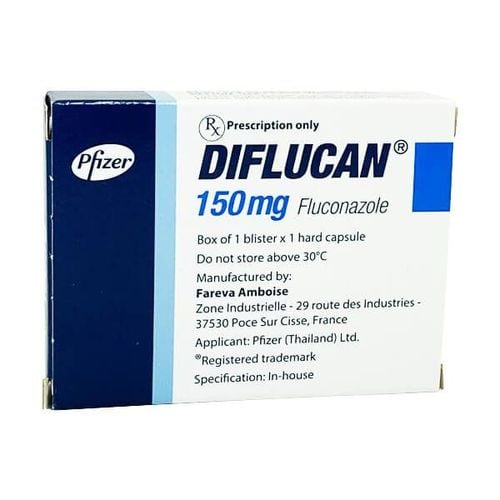This is an automatically translated article.
Fluxar belongs to the group of drugs that treat parasites, anti-infectives, antivirals and antifungals. Fluconazole is the active ingredient in the drug. So what does Fluxar do? Let's find out information about Fluxar drug in the article below.
1. What is Fluxar?
Fluxar belongs to the group of anti-parasitic, anti-infective and anti-fungal drugs. Indicated in the treatment of vaginal candidiasis or fungal skin diseases such as foot fungus, ringworm and onychomycosis.
Fluxar medicine has the main active ingredient Fluconazole 2mg/ml. Prepared in the form of an infusion solution, packing is a box of 1 bottle of 100ml.
2. What are the effects of Fluxar?
2.1. Pharmacodynamics Fluxar is composed of the active ingredient Fluconazole of the triazole group, which has peripheral or systemic antifungal effects. In particular, fluconazole is active against most strains of Candida, including end-stage fungal infections of AIDS patients, which are resistant to other antifungal agents such as Nystatin, Ketoconazole and Clotrimazol.
2.2. Pharmacokinetics The bioavailability of fluconazole is over 90% when administered orally compared to intravenous administration. Peak plasma concentrations are reached in 1 to 2 hours in normal patients. The half-life is approximately 30 hours after oral administration. Fluconazole is eliminated primarily by the kidneys, with about 80% of the dose appearing in the urine unchanged, and 11% as metabolites. Fluxar is indicated for use in the following cases:
Treatment of vaginal candidiasis. Treatment of skin fungus: Foot fungus, body fungus, nail fungus, inguinal fungus and tinea versicolor.
3. How to use Fluxar
3.1. How to use Fluxar For Fluxar, patients use it orally.
3.2. Dosage of Fluxar: The recommended dose of Fluxar for each subject is as follows:
Patients with oropharyngeal candidiasis: Use a dose of 50-100mg/day, treat for 1 to 2 weeks. Patients with vaginal candidiasis: 150mg single dose. Patients with fungal infections of the feet, trunk, and groin: Use 150mg/time/week. Patients with cryptococcal meningitis: Initial dose is 400mg/day. Then use a maintenance dose of 200mg/day for at least 6 to 8 weeks. Treatment to prevent recurrence of Cryptococcus: Use a dose of 100-200mg/day. Elderly patients: If there are no signs of renal impairment, the usual dose can be used. If there are signs of renal impairment (creatinine clearance less than 40 ml/min), the dose should be adjusted accordingly. Patients with renal impairment: Single-dose regimens do not require dose adjustment. For multiple-daily regimens, take the usual dose for 1-2 days, then adjust the interval between doses. Note: It is necessary to apply the exact dose of Fluxar recommended on the package, the leaflet or follow the doctor's instructions. The patient did not arbitrarily adjust the dose of Fluxar.
3.3. How to handle when forgetting, overdosing Fluxar medicine Missed dose:
There are no reports of adverse effects when forgetting a dose of Fluxar. However, to ensure the most accurate effect when using the drug, patients need to follow exactly as prescribed by the doctor. If you miss a dose, you can take a supplement within 1-2 hours after the prescribed time. Never use 2 doses too close together or at the same time.
Overdose:
If you experience any adverse effects when taking an overdose of Fluxar, the patient should immediately notify the nearest doctor or medical facility. The patient's family needs to record all prescriptions that have been and are being used to be able to diagnose and treat in the most accurate way.
3.4. Fluxar is contraindicated in the following cases:
Cases where the patient is allergic, sensitive to Fluconazole or any of its ingredients. Cases of patients with hypersensitivity to compounds of the trinazol group.
4. Precautions when using Fluxar
Notes and cautions when using Fluxar:
For patients with renal failure: Use caution when using Fluxar on this subject. Consider an appropriate dose adjustment of Fluxar. For children under 16 years of age: Because there are no clinical studies in children under 16 years of age, Fluxar should not be used in this population. For women who are pregnant and breast-feeding: A doctor should be consulted and the benefits/risks for mother and baby should be weighed before making a decision to use Fluxar. Driving and using machines: There is no evidence that the use of this drug affects the ability to drive and use machines. However, some side effects with Fluxar should be considered that may be detrimental to your ability to perform these activities. Side effects when using Fluxar:
When using Fluxar, you may experience the following undesirable effects:
Nausea, vomiting, abdominal pain, flatulence and diarrhea. Swelling. Rare: Anaphylaxis. If other adverse symptoms are suspected while using Fluxar, the patient should stop taking the drug and notify the treating physician or medical officer immediately.
Interactions and incompatibilities with Fluxar drugs:
Patients need to consider when using Fluxar with agents that can change the ingredients in the drug such as alcoholic or fermented drinks, tobacco... See details in Fluxar. leaflet or consult your doctor.
Studies or recommendations usually only state common drug interactions. Therefore, do not arbitrarily apply information on Fluxar drug interactions if you are not a doctor, medical person or researcher. Keep the medicine in a dry place, away from moisture and avoid direct sunlight. Carefully read the instructions on how to store the medicine on the packaging. Above is all necessary information when using Fluxar medicine. Fluxar is a prescription drug, and patients must not use it or adjust it on their own without the approval of the treating doctor or medical person in charge.
Please dial HOTLINE for more information or register for an appointment HERE. Download MyVinmec app to make appointments faster and to manage your bookings easily.













